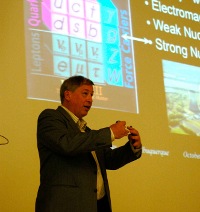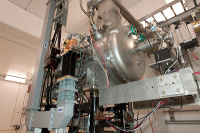The mysterious Universe – brought to Albuquerque
Public lecture draws impressive crowd

Jim Brau's lecture on the mysterious Universe attracted a wide Albuquerque public. |
Even though University of Oregon professor and Americas regional contact for the ILC physics and detectors studies Jim Brau had specifically invited a young audience to his public lecture on 1 October in the University of Albuquerque, he thought of teenagers and university students rather than seven–year–olds. But Brau gave particle physics one of its youngest fans — little Abigail Zwartz was so gripped by his talk that she took notes eagerly and even presented them in school the next day.
Read more...
-- Barbara Warmbein |
|
 |
From Fermilab Today: SRF cryogenics system proves its 'cool' factor

Engineers recently cooled this SRF test unit to 2 degrees Kelvin, or minus 271 degrees Celsius
|
Fermilab has passed another major milestone on the road to becoming an expert in superconducting radio frequency technology.
In early October, in the first test of the cryogenics system at the RF–unit test facility at the New Muon Lab, Fermilab engineers cooled a superconducting capture cavity to 2 degrees Kelvin, or minus 271 degrees Celsius. This is the temperature needed for cavities that could be used in next-generation accelerators such as the proposed Project X. The successful test was the final step in commissioning the cryogenic system at the new test facility.
Read more...
-- Tona Kunz |
 |
|
|
 |
From Science Daily
2 November 2009
Dark Matter And Dark Energy Make Up 95 Percent Of Universe, Detailed Measurements Reveal
A detailed picture of the seeds of structures in the universe has been unveiled by an international team ..
Read more... |
|
From CERN Courier
30 October 2009
Accelerator R&D gets a collaborative boost
The EU Commission and partners from universities, research centres and industries throughout Europe have launched EuCARD, a new four–year project centred on accelerator R&D for high–energy physics, nuclear physics and light sources, co–ordinated by CERN.
Read more... |
|
|
 |
 |
|
|
 |
Report on the CLIC workshop

The Compact Linear Collider based on a two–beam concept |
The September ALCPG and ILC meeting in Albuquerque, US, featured a plenary talk on the Compact Linear Collider Study CLIC by Jean–Pierre Delahaye, who gave a very nice description of the CLIC status and plans. His talk was well received by the ILC audience and it represented another step in our efforts to increase communication and cooperation between the two groups. In return, I gave a plenary talk on the ILC status and plans at the CLIC09 Workshop at CERN on 12 October. Like Delahaye in Albuquerque, I was also warmly received at the CLIC workshop and was pleased to have the opportunity to reciprocate to the CLIC audience. This group of dedicated scientists is working towards the same ultimate goal, a future lepton collider for our field to complement the LHC. An extra benefit for me personally was that participating in the workshop gave me effectively an intense crash course on CLIC. Today, I share a few personal observations from the workshop.
Read more...
-- Barry Barish
Director's Corner Archive |
 |
|
|
 |
Trick or glitch?
Last Sunday, 1 November, we experienced a domain name glitch, which left our readers and ILC collaborators unable to browse the linearcollider.org website or perform their work as normal. The issue was identified and fixed immediately, in the effort of restoring service as soon as possible. Neverthless, it took several hours for the fix to reach the entire network. The reason of the glitch is still under investigation.
The ILC web team apologises for any inconvenience caused.
arXiv preprints
0911.0006
SiD Letter of Intent
|
|

